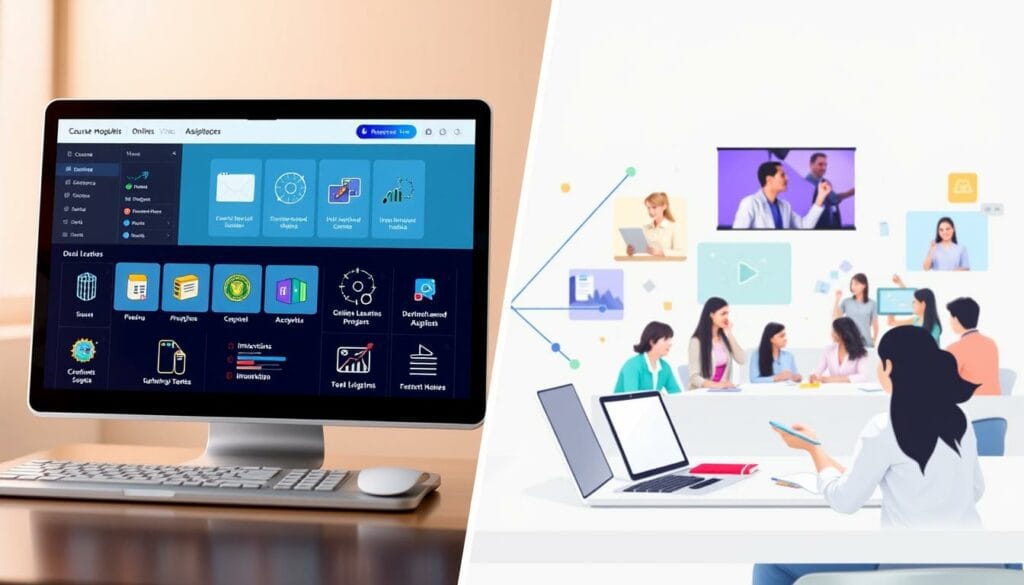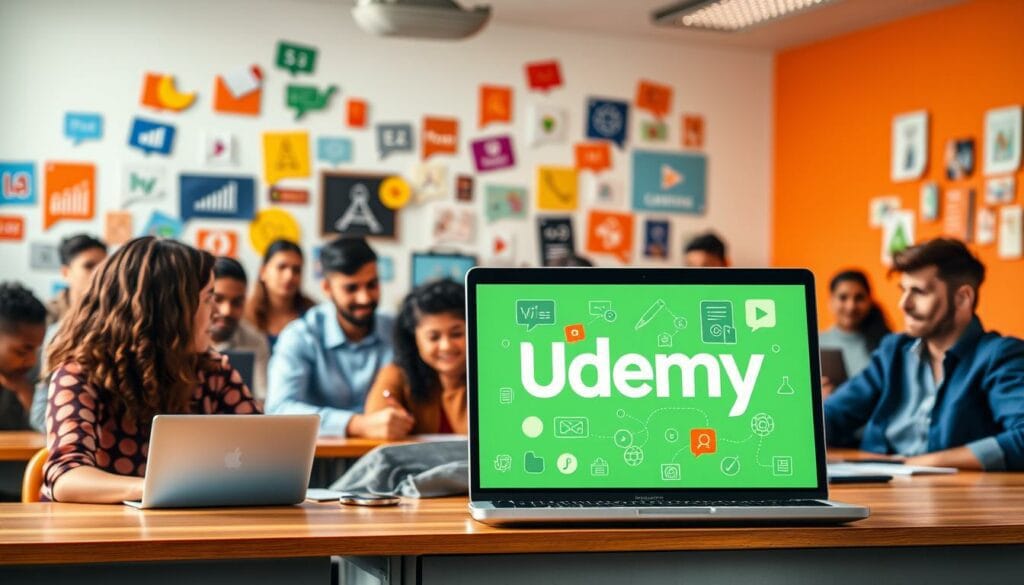Top 10 Online Learning Platforms for Students in 2024

Table of Contents
Did you know over 60% of online learning platforms offer free courses? This makes education more accessible than ever. It shows how digital education is growing, allowing students to learn many topics without spending money1. Online learning is becoming more important, with ratings from 3.4/5 to 4.7/52. As we move into 2024, it’s key for students to use these e-learning tools to learn more from home.
In this article, I’ll look at the top 10 online learning platforms for 2024. They offer everything from free courses to full qualifications. Prices vary, from free to $250 a year for premium plans2. Each platform has its own special features, fitting different learning styles and needs.
Key Takeaways
- Over 60% of online learning platforms provide free courses, expanding access to education.
- G2 Score ratings for top platforms range from 3.4/5 to 4.7/5, reflecting quality feedback.
- Pricing for online courses varies widely, making them accessible to different budgets.
- Each platform has a unique value proposition catering to various learning styles and needs.
- Learning online allows students to study at their own pace, offering flexibility in education.
Introduction to Online Learning Platforms
Online learning platforms have changed the way we learn, making many courses available to everyone. They offer different types of learning, from school subjects to professional skills. In the U.S., more students are choosing online classes for the 14th year in a row, even as college enrollment drops3.
The global e-learning market is expected to grow to over $243 billion. This shows a big demand for learning online3.
In the U.S., there are 3,868 accredited, nonprofit colleges and universities, according to Forbes Advisor. This means there’s a lot of competition in online learning4. Online courses fit into your schedule, offering flexibility that traditional classes can’t match. The COVID-19 pandemic has made distance learning even more important, showing how education must adapt3.
Learning Management Systems (LMS) like Canvas, used by Ivy League schools, show how technology and education come together. These systems help organize courses and make learning more engaging. There are free and affordable LMS options, helping schools find what works best for them4.
The Value of Online Learning in Modern Education
Online learning has changed education by making it easier and cheaper. Over 30 percent of students in the U.S. take at least one online course5. This shows online learning is getting more popular, with 90 percent of students thinking it’s as good as or better than in-person classes5.
Today, education uses technology to let students learn at their own pace. This helps them balance work and study better.
Online classes are often smaller, which means more one-on-one time with teachers5. This helps students have more conversations and share resources, making learning richer6. Online courses also use videos, eBooks, and multimedia to encourage creativity and thinking7.
Online learning lets students from all over learn at any time6. It’s also cheaper thanks to scholarships and discounts. Plus, payment plans help with costs5. This makes learning more accessible and tailored to each person’s needs7.
Online learning tools create lively communities where students share ideas worldwide7. But, students need to be good with computers, disciplined, and manage their time well6. The use of technology in online learning is changing education and will be key for future learning.
Factors to Consider When Choosing an Online Learning Platform
Choosing an online learning platform involves looking at several key factors. User experience is crucial, with 74% of educators and business owners saying it’s top priority8. The platform’s design greatly affects how well course content is presented. A good design makes it easy to navigate and keeps learners engaged.
Cost is also important. 63% of users value affordability and scalability8. Businesses also look for cost-effective options, with 86% focusing on compatibility and usability8. Additionally, 82% of businesses want a Learning Management System (LMS) that can grow with their needs8.
Having a supportive community is key. I like platforms with strong customer service, as 69% of users find it essential8. Customizable access to resources is also great for personalizing learning paths.
Security is a must, with 76% of organizations valuing data protection and analytics8. I look for platforms that integrate well with other systems, a need for 67% of organizations8. The right mix of these factors makes a platform suitable for my learning needs.
Online Learning Platforms vs. Learning Management Systems
It’s important to know the difference between online learning platforms and learning management systems. Online learning platforms are where students take courses directly. Learning management systems (LMS) help teachers make and manage courses. They have tools for videos, quizzes, and grading to improve learning9.
LMSs have many features like sharing files and working together, but online learning platforms mainly host courses9. Setting up LMSs is harder and takes longer than online learning platforms, which are more flexible9. Schools and companies often use both to get the most from their technology, picking what works best for them10.
Here’s a quick comparison:
| Feature | Online Learning Platforms | Learning Management Systems (LMS) |
|---|---|---|
| Focus | Course hosting and delivery | Course creation and administration |
| User Interface | Attractive, easy to use | Can be complex and clunky |
| Setup Time | Quick and flexible | Long and complex |
| Integration Capability | Limited integrations | Extensive integrations with CRM, CMS, etc. |
| End-User Experience | Drag-and-drop functionality, mixed media support | Robust but may lack user-friendly design |

Overview of the Top 10 Online Learning Platforms
Today’s education world is changing fast. Many platforms are great at meeting different learning needs. Udemy is the biggest, with over 213,000 classes and more than 70,000 instructors11. It has lots of courses for all kinds of interests and skill levels.
Coursera works with universities and groups, offering over 3,000 courses. It has attracted more than 87 million users worldwide11. This platform helps learners get certified, which is good for their careers.
Skillshare is all about creative skills. It has almost 70 creative topics for just $14 a month. It’s great for those who want to get creative or learn for fun11.
edX was started by big names like Harvard and MIT. It has lots of college courses on different subjects. This gives learners a deep academic experience11. Udacity focuses on tech skills with “nano degrees” for about $399 per month. These are perfect for those in tech fields11.
freeCodeCamp is a free option with 1,400 hours of coding challenges. It shows that learning doesn’t have to cost a lot11. 360 Training is great for learning about government rules, with over 6,000 courses in more than 15 industries11.
The eLearning world is growing fast. It’s expected to hit USD 370 billion by 2026, up from USD 226 billion in 2020. This shows how much we rely on tech for learning12.
With so many platforms out there, each with its own special area, students have lots of choices. They can pick the one that fits their learning goals best.
Thinkific: Custom Course Creation for Students
Thinkific is a top choice for teachers wanting to create custom courses online. It gives a solid setup for making courses that fit different learning needs. Its easy-to-use design helps teachers make engaging courses.
Pros and Cons of Thinkific
Thinkific’s 14-day free trial is a big plus, letting you try it out first13. It comes with pre-made course templates to help beginners. You can also add your own content quickly, saving time.
It offers many ways to take courses, like self-paced or live lessons. Students can even join live webinars through Zoom13.
However, Thinkific doesn’t have a big library of courses. This might be a problem if you’re looking for pre-made materials. Setting it up can also be tough for those not tech-savvy.
Pricing and Course Options
Thinkific starts with a free plan for those on a tight budget. Paid plans start at $149 a month, offering more features. You can set your own course prices, including free ones.
Plus, Thinkific automatically gives out completion certificates when students finish a course. This makes students feel accomplished and happy13.

Coursera: Earn Accredited Certificates and Degrees
Coursera is a top choice for getting accredited certificates and degrees. It offers a wide range of online courses from universities like Stanford and Yale. This partnership brings high-quality learning to your fingertips.
Each course includes video lectures, readings, quizzes, and peer-reviewed assignments. This mix creates a lively and interactive learning space.
Course Offerings and Structure
Coursera’s certificate programs usually last from three to seven months. This is a flexible way to get higher education without a long-term commitment14. The cost varies, from $50 a month to $6,000, which is more affordable than traditional tuition14.
Many courses are free to start, letting you try out different subjects without spending a dime.
Course lengths vary by institution. For example, the University of Illinois Urbana-Champaign’s graduate certificate programs last about 6 months. Meanwhile, the University of Colorado Boulder’s programs take 6 to 12 months15. This flexibility is great for working professionals, allowing them to learn at their own pace from anywhere.
Learning on Coursera can boost your skills and job prospects. It’s shown to increase employment chances and earning potential14.
LinkedIn Learning: Professional Development Opportunities
LinkedIn Learning is a key resource for those looking to grow professionally. It has over 17,000 online courses to improve job skills. The 2023 LinkedIn Workplace Learning Report shows that job seekers value professional development highly16.
By joining LinkedIn Learning, I can add certifications to my LinkedIn profile. This shows my dedication to personal growth. Studies reveal that learners watch 69% more content when it’s tailored to them16. This makes vocational training more effective, as it matches my career goals.
I also like that the platform uses tests before and after courses to check if I’ve learned. These tests help track my progress and spot areas I need to work on16.
The cost of a subscription is $39.99 a month or $239.88 a year. This investment can open up better job opportunities. After all, 76% of businesses see digital skills as key to success17.

| Subscription Options | Monthly Cost | Annual Cost | Course Availability |
|---|---|---|---|
| Basic Plan | $39.99 | $239.88 | 17,000+ |
In summary, LinkedIn Learning is a top choice for professional growth. It offers a wide range of courses and valuable assessment tools.
Skillshare: Creative Skills and Projects for Everyone
Skillshare is a top platform for learning creative skills. It offers over 25,000 classes in areas like graphic design, photography, and animation18. This vast selection attracts many learners and creates a strong community with over 600,000 members and 8,000 teachers18.
The platform is great for learning because it encourages community involvement. Students can connect with others and get help from teachers. This makes learning more fun and supportive.
Community Support and Engagement on Skillshare
Skillshare is a place where people can work together on projects and challenges19. It offers learning paths to help users reach their goals18. The community is key for improving skills, as members share tips and feedback19.
Users can learn to use tools like Procreate and Photoshop to improve their skills20. Premium members get unlimited access to special classes, adding to their learning resources20. Skillshare also offers free trials, making it easy for beginners to start learning.
| Feature | Details |
|---|---|
| Classes Offered | 25,000+ |
| Members | 600,000+ |
| Teachers | 8,000+ |
| App Rating | 4.8/5 |
| Creative Topics | Graphic Design, Photography, Animation, Writing, and more |
edX: Partnering with Ivy League Schools
edX started in 2012 by Harvard and MIT. It aims to offer top-notch online learning with help from famous schools. Today, 82 partner organizations work with edX, bringing a wide range of learning options to students everywhere. Six Ivy League schools, like Princeton and Penn, are part of this effort. This makes edX a top choice for those wanting Ivy League education online21.
On edX, you can find over 3,000 online courses, MicroMasters, and Professional Certificates. Many courses are free to audit, but you can pay for verified certificates. Prices range from $50 to $300. The courses are flexible, allowing students to learn at their own speed. This is something that Princeton and others support21 and22.
edX works to solve job shortages, especially in healthcare and education, with over 100,000 job placements. It also focuses on making tech more diverse. Partners like Netflix and local colleges help edX reach more people with its mission22.

OpenLearning: Microcredentials and Collaborative Learning
OpenLearning leads in distance education, focusing on microcredentials. It values collaborative learning, where learners work together and share knowledge. This approach makes learning more real and connected.
Microcredentials on OpenLearning are short, affordable courses. They give learners digital certifications or digital badges when they finish. These badges are key in today’s job market, helping people stand out. 74% of workers want to learn new skills, showing how important microcredentials are23.
The OpenCreds framework meets the needs of both industries and education. It helps learners improve their skills or change careers. Projects on this platform get 18 times more engagement than traditional learning23.
OpenLearning has over 30 tools for educators to create engaging activities. Since 42% of job skills will change soon24, its focus on adaptive microcredentials is crucial.
| Feature | Details |
|---|---|
| Microcredentials | Short, low-cost courses with digital badges |
| Collaborative Learning | Social engagement through project collaboration |
| OpenCreds Framework | Designed for upskilling and obtaining certifications |
| Course Engagement | 18x higher engagement in social learning |
| Global Reach | Over 2.5 million learners across 180 countries |
OpenLearning is key for those wanting to improve their skills through microcredentials and teamwork. It creates a community in distance education where learners can grow together.
Learning here fights against skill loss and empowers people of all ages. It makes education a lifelong journey24.
Udemy: The Largest Selection of Online Courses
Udemy is the biggest online learning site, offering many courses for different interests and skills. Courses cost from $10 to $200, giving learners lots of choices. It’s easy to learn at your own pace without any rush.
Udemy also has a 30-day money-back guarantee. This makes me feel secure when trying out new courses. Even though some courses might not be perfect, Udemy is still a great place for learning various skills.

| Course Type | Price Range | Refund Policy | Learning Style |
|---|---|---|---|
| Variety (e.g., tech, arts, business) | $10 – $200 | 30-day money-back guarantee | Self-paced |
| Certifications | Varying fees | Available for unsatisfactory courses | Digital content |
| Vocational Training | Typically $15 – $150 | Risk-free for 30 days | Video lectures, quizzes |
Udemy shows how easy and varied online learning can be. It’s a great place for anyone looking to learn more.
I appreciate the range of educational resources available on Udemy, which makes it easier for me to pursue my career goals.
Treehouse: Focusing on Coding and Web Development
Treehouse is a top choice for online courses, especially for coding and web development. It offers over 300 courses on programming and design. This helps learners get the skills they need for their careers25.
Treehouse has subscription plans from $25 to $49 a month, with a free 7-day trial. This makes learning advanced topics affordable25. The courses are for all levels, focusing on topics that are in demand in the tech world26.
Treehouse’s Techdegree program is unique. It offers a bootcamp-style curriculum with projects, workshops, and quizzes27. This program helps students learn deeply in their chosen fields, like Front End Web Development or Python Development. It can take two to five months to complete, depending on the track27.
Treehouse makes learning interactive with quizzes and code challenges. This helps learners apply what they learn in a practical way26. They encourage users to spend just 30 minutes a day on their courses. This can help learners get the skills needed for a job27.
The platform also has community forums for networking. Students can connect and share insights26.
The Techdegree program focuses on real-world projects. This gives learners valuable hands-on experience and project reviews25. They get to work on assignments that are like real-world challenges. Even though Treehouse doesn’t offer accredited certificates, the skills gained can boost your resume for a tech career25.
MasterClass: Learning from Industry Experts
MasterClass is a unique online learning platform. It lets you learn from famous industry experts and celebrities. You can explore a wide range of topics, from writing to cooking.
The cost is about $10 a month, billed yearly. This is much cheaper than traditional learning methods, which can cost thousands28.
The platform offers high-quality video lessons. Each lesson is short, lasting from a few minutes to 20 minutes. This makes it easy to fit into your busy schedule28.
Notable instructors like Gordon Ramsay and Serena Williams teach on the platform. They share their expertise, helping you improve your skills and knowledge29. This focus on professional development helps you grow both personally and in your career.
While MasterClass provides foundational knowledge, some topics might seem less advanced. Yet, learning from top professionals is incredibly valuable. MasterClass also values diversity and inclusion, making learning accessible to everyone30.

Khan Academy: Free Educational Resources for All Levels
Khan Academy offers free education for everyone. It’s great for K-12 students and has lots of resources to help them learn. These resources are designed to improve learning outcomes.
The platform covers many subjects and has interactive lessons. It helps students learn without worrying about money. The Khan Academy Kids program is especially good for young kids, helping them with reading and learning skills31.
It was made with experts from Stanford. It fits with the Head Start and Common Core Standards31.
The program also has learning paths that fit each student’s needs. Parents love it, as shown by many positive comments on Twitter31. It has fun activities, books, videos, and coloring pages for kids to learn on their own.
Khan Academy Kids is special because it uses fun characters to teach kids. It’s free, with no ads or subscription fees31. Learning in the morning is best, especially for math32. Kids should practice math for at least 30 minutes a day to get better32.
Khan Academy also has grammar and writing activities. These help kids think creatively and critically. It even has computer programming to boost creativity in kids32. I like how it balances learning with relaxation and family time.
Conclusion
The rise of online learning platforms has changed how we see education. It’s now available and flexible for students all over. Each platform has special features for different learning needs, which is key in today’s fast world.
I found that people want learning that is easy, flexible, and mixed. This is because teaching needs to be adaptable and open to change33.
Now, schools focus on their staff’s well-being, which helps students too. This is especially true for BIPOC and marginalized students who often struggle to get an education34. Working with these resources is crucial for building good relationships between students and teachers.
Teachers are moving from old lectures to more hands-on learning3335. Also, using technology and digital skills will shape the future of learning.
In the end, the world of e-learning will keep growing. It offers endless chances for personal growth and career progress. It’s clear that using these new learning tools is essential for staying ahead in a digital world.
As I look ahead, I plan to dive deeper into these platforms. I want to find the best one for my learning path333435.
FAQ
What are online learning platforms?
Online learning platforms are digital spaces where you can find many courses and educational content. They help you learn in a flexible way, offering resources for all kinds of learners.
How do I choose the right online learning platform for my needs?
Look at the courses, community support, cost, and how the platform is set up. Think about what you want to learn, how you like to learn, and how much you can spend. This will help you pick the best platform for you.
What is the difference between online learning platforms and learning management systems?
Online learning platforms are for learners, where you can dive into courses directly. Learning management systems are for teachers, helping them manage courses. Both are important for a good learning experience.
Can I earn a degree or certification through online learning platforms?
Yes, many platforms offer degrees and certifications from real universities. You can take tests and get recognized for your learning.
Are online courses suitable for professional development?
Absolutely! Online courses are great for growing your skills and learning new things. They help you meet your career goals and keep up with industry trends.
What types of courses are available on online learning platforms?
You can find courses on many subjects, like school subjects, creative skills, coding, and more. Whether you want to learn for fun or for work, there’s something for you.
Are there free online courses available?
Yes, many platforms offer free courses and resources. While some advanced features might cost money, you can often get basic materials for free.
How flexible are online learning courses?
Online courses are very flexible. You can learn at your own pace and whenever you want. This is perfect for people with busy lives.
Can I access materials and courses on mobile devices?
Most platforms work on phones and tablets. This means you can learn anywhere, anytime, making digital education very convenient.
How can I engage with other learners in an online setting?
Many platforms have forums, group projects, and ways to interact with others. This helps you learn from others and share your own ideas, making learning more fun and valuable.
Source Links
- https://www.pcmag.com/picks/best-online-learning-services
- https://www.thinkific.com/blog/online-learning-platforms/
- https://www.mycomputercareer.edu/what-are-online-learning-platforms/
- https://www.forbes.com/advisor/education/career-resources/online-learning-platforms/
- https://www.educations.com/articles-and-advice/5-reasons-online-learning-is-future-of-education-17146
- https://www.uis.edu/ion/resources/tutorials/overview/strengths-weaknesses
- https://www.swiftelearningservices.com/role-of-elearning-in-modern-education/
- https://blog.braincert.com/5-things-to-consider-when-choosing-an-e-learning-platform/
- https://elearningindustry.com/lms-vs-elearning-platforms-key-differences
- https://www.skilljar.com/blog/lms-vs-elearning-platform
- https://career.io/career-advice/top-10-online-learning-platforms
- https://www.paradisosolutions.com/blog/list-of-online-learning-platforms/
- https://www.thinkific.com/features/create-digital-products/online-course-platform/
- https://www.coursera.org/articles/certificate-programs
- https://www.coursera.org/certificates/learn
- https://learning.linkedin.com/resources/career-development/7-ways-to-improve-professional-development
- https://learning.linkedin.com/resources/career-development/development-opportunities-employees-tech
- https://www.skillshare.com/en/
- https://jitneys.co/blog/2015/9/24/why-i-love-skillshare
- https://apps.apple.com/au/app/skillshare-creativity-classes/id916819843
- https://www.thecrimson.com/article/2015/10/2/edx-ivy-league-coursera/
- https://press.edx.org/tag/partner-impact
- https://appsource.microsoft.com/fr-ca/product/web-apps/openlearningglobalptyltd.openlearning?tab=Overview
- https://solutions.openlearning.com/opencreds/opencreds-learners
- https://upskillwise.com/reviews/treehouse/
- https://teamtreehouse.com/
- https://teamtreehouse.com/techdegree
- https://finessetosuccess.com/masterclass-courses-to-level-up-professionally/
- https://en.wikipedia.org/wiki/MasterClass
- https://careers.masterclass.com/
- https://learn.khanacademy.org/khan-academy-kids/
- https://keeplearning.khanacademy.org/daily-schedule
- https://www.educause.edu/ecar/research-publications/2024/the-teaching-and-learning-workforce-in-higher-education-2024/conclusion-recommendations-and-resources
- https://steinhardt.nyu.edu/metrocenter/research-evaluation/section-4-conclusion-and-recommendations
- https://davidbmorris.medium.com/educating-about-education-conclusion-546a0f992bf1


